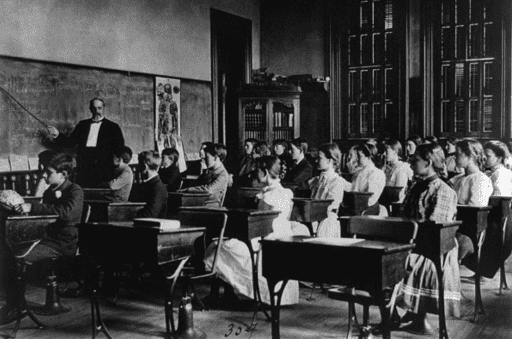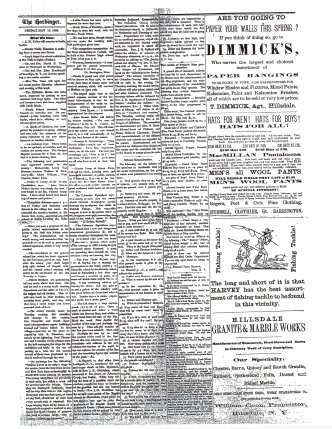Local History

Could You Pass This Test?
Our friend and fellow history buff Sally Laing recently gave us a copy of a news clipping from the April 17, 1889 edition of the Hillsdale Harbinger. The clipping is of an article listing half of the questions on the arithmetic exam that was given to the students, presumably eighth graders, at the Hillsdale School. We say “presumably” because as we noted in a prior post, Hillsdale did not have a high school until 1903. In the 19th century, an eighth-grade education was considered adequate for finding work in agriculture, the manual trades, or in a retail establishment.
The article notes that the other half of the exam had been published in the prior week’s Harbinger, but we were unable to locate that issue. In any case, what we do have is, we think, daunting enough.
Here’s the page from the Harbinger with the article, which starts in the third column, about one-third of the way down. (We know you can’t read it.)
Unfortunately, we are not able to provide a clearer view within the limitations of the WordPress platform, but here’s the list of questions, which starts with #31. (We wonder if students who noticed that there were two questions numbered 47 and no question numbered 50 got extra credit.) Keep in mind that students would have had to figure out the answers without the assistance of calculators or smart phones.
31. Find specific duty on 173 kegs of tobacco, 125 pounds each, at 6 cents per pound; tare 6 pounds per keg.
32. Define (a) real estate. (b) personal property. (c) taxes.
33. Amount of taxable property in a school district, $287,590; tax $1,200. Find the rate and the tax on property worth $45,600.
34. A man owes A. $400. B. $500. C. $500. His property is worth $1,000. What per cent of his debts can he pay, and how much will A. B. and C. receive?
35. A man said that 2/3, 3/4, and 5/6 of his money was $980. How much money had he?
36. A post stands 40 feet above the water, ¼ in the water and 1/6 in the mud. What is the length of the post?
37. Define and illustrate involution.
38. What are the factors of a number? Illustrate.
39. In the expressions of 62, 83 etc., what general name is given to the small figures?
40. Expand 52, 63, 72 and 84, and indicate the process.
41. Define and illustrate evolution.
42. What is meant by the root of a number?
43. In the expressions 6-1/2, 8-1/3 etc., what general name is given to denominators of the fractions in small figures?
44. Define and illustrate ratio.
45. What is proportion? Illustrate.
46. If 40 acres of land $540, with will 97 acres cost? Solve by proportion.
47. If 3/7 of a cord of wood cost $1.35, what will 6/7 of a cord cost? By proportion.
47. If 15 men in 12 hours a day can hoe 60 acres in 20 days, how many days of 10 hours each will it take 18 men to hoe 96 acres.
48. A cistern contains 216 cubic feet. How many gallons will it hold?
49. One horse eats 19-3/7 bushels of oats in 87-3/7 days, how many bushels will 7 horses eat in 60 days?
51. How many pounds Troy weight in 180 pounds avoirdupois?
52. Reduce (2,9S5,9S4)1/2
53. Extract the 6th root of 148,035,889
54. A hhd. of molasses was bought for a certain sum of money; 15 gal. leaked out and the remainder was sold at $2.21-2/3 per gallon and lost 5 per cent on the cost. What was the cost?
55. How many feet of boards can be cut from a log 11 feet long and 12 inches square, each board to be 2/3 of an inch thick?
56. How many acres in a field a K’m long and 15 Hm wide?
57. The hind wheel and the fore wheel of a wagon are respectively 4 feet and 3 feet in diameter. What is the circumference of each and how many more times would the fore wheel turn than the hind one in going one mile?
58. A house is 20 feet high, how long must a ladder (placed 10 feet from the house) be to reach the top?
59. Define and illustrate the terms used in multiplication.
60. Prove that 1728 divided by 12 = 144.
Some of these questions seem to us to stray from the precise definition of mathematics, like #32. In any case, we’ll leave it to you to pick out your favorite head-banging question.
Quite a test for an eighth grader. In fact, if you take math majors out of the picture, we suspect that the average college freshman of today would have considerable difficulty passing this exam! We know a couple of town historians who would. For our own dignity, we’d like to point out that it’s not fair to compare how an adult might fare after being out of school for decades versus eighth graders who have spent the last year studying and being drilled on the concepts in this exam.
Still, when Dictionary.com revealed to us that in mathematics, involution is “a function that is an inverse of itself,” we had to take a short lie-down.
Follow the Hillsdale Historians and see their latest blog posts as well as past stories by signing up here.

